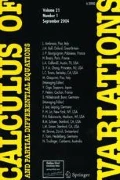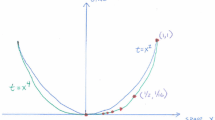Abstract
We consider the reduced Allen–Cahn action functional, which arises as the sharp interface limit of the Allen–Cahn action functional and can be understood as a formal action functional for a stochastically perturbed mean curvature flow. For suitable evolutions of (generalized) hypersurfaces this functional consists of the integral over time and space of the sum of the squares of the mean curvature and of the velocity vectors. Given initial and final conditions, we investigate the associated action minimization problem, for which we propose a weak formulation, and within the latter we prove compactness and lower-semicontinuity properties of a suitably generalized action functional. Furthermore, we derive the Euler–Lagrange equation for smooth stationary trajectories and investigate some related conserved quantities. To conclude, we analyze the explicit case in which the initial and final data are concentric spheres. In this particular situation we characterize the properties of the minimizing rotationally symmetric trajectory in dependence of the given time span.
Similar content being viewed by others
References
Allard, W.K.: First variation of a varifold. Ann. Math. 2(95), 417–491 (1972)
Allen, S.M., Cahn, J.W.: A microscopic theory for antiphase boundary motion and its application to antiphase domain coarsening. Acta Metall. 27, 1085–1095 (1979)
Bellettini, G., Mugnai, L.: Some aspects of the variational nature of mean curvature flow. J. Eur. Math. Soc. (JEMS). 10(4), 1013–1036 (2008)
Brakke K.: The Motion of a Surface by its Mean Curvature. Princeton University Press (1978)
de Mottoni, Piero, Schatzman, Michelle: Development of interfaces in \({ R}^N\). Proc. Roy. Soc. Edinb. Sect. A 116(3–4), 207–220 (1990)
E, W., Ren, W., Vanden-Eijnden, E.: Minimum action method for the study of rare events. Commun. Pure Appl. Math. 57(5), 637–656 (2004)
Evans, L.C., Soner, H.M., Souganidis, P.E.: Phase transitions and generalized motion by mean curvature. Commun. Pure Appl. Math. 45, 1097–1123 (1992)
Faris, W.G., Jona-Lasinio, G.: Large fluctuations for a nonlinear heat equation with noise. J. Phys. A 15(10), 3025–3055 (1982)
Feng, J.: Large deviation for diffusions and Hamilton-Jacobi equation in Hilbert spaces. Ann. Probab. 34(1), 321–385 (2006)
Fogedby, H.C., Hertz, J., Svane, A.: Domain wall propagation and nucleation in a metastable two-level system. Phys. Rev. E. 70, 031105-1-031105-17 (2004)
Hutchinson, J.E.: Second fundamental form for varifolds and the existence of surfaces minimizing curvature. Indiana Univ. Math. J. 35, 45–71 (1986)
Ilmanen, T.: Convergence of the Allen-Cahn equation to Brakke’s motion by mean curvature. J. Diff. Geom. 38, 417–461 (1993)
Kohn, R., Otto, F., Reznikoff, M.G., Vanden-Eijnden, E.: Action minimization and sharp-interface limits for the stochastic Allen-Cahn equation. Commun. Pure Appl. Math. 60(3), 393–438 (2007)
Kohn, R.V., Reznikoff, M.G., Tonegawa, Y.: Sharp-interface limit of the Allen-Cahn action functional in one space dimension. Calc. Var. Part. Differ. Equ. 25(4), 503–534 (2006)
Kuwert, E., Schätzle, R.: The Willmore flow with small initial energy. J. Diff. Geom. 57, 409–441 (2001)
Kuwert, E., Schätzle, R.: Removability of point singularities of Willmore surfaces. Ann. Math. 2. 160(1), 315–357 (2004)
Marques, F.C., Neves, A.: Min-Max Theory and the Willmore conjecture. ArXiv e-prints (2012)
Michor, P.W., Mumford, D.: Riemannian geometries on spaces of plane curves. J. Eur. Math. Soc. (JEMS) 8(1), 1–48 (2006)
Moser, R.: A generalization of Rellich’s theorem and regularity of varifolds minimizing curvature. Preprint. http://www.mis.mpg.de/publications/preprints/2001/prepr2001-72.html (2001)
Mugnai, L., Röger, M.: The Allen-Cahn action functional in higher dimensions. Interfaces Free Bound. 10(1), 45–78 (2008)
Okabe, S.: The variational problem for a certain space-time functional defined on planar closed curves. J. Differ. Equ. 252(10), 5155–5184 (2012)
Rivière, T.: Analysis aspects of Willmore surfaces. Invent. Math. 174(1), 1–45 (2008)
Röger, M., Tonegawa, Y.: Convergence of phase-field approximations to the Gibbs-Thomson law. Calc. Var. Part. Differ. Equ. 32(1), 111–136 (2008)
Rubinstein, J., Sternberg, P., Keller, J.B.: Fast reaction, slow diffusion, and curve shortening. SIAM J. Appl. Math. 49(1), 116–133 (1989)
Simon, L.: In: proceedings of the center for mathematics analysis. Lectures on Geometric Measure Theory, vol. 3, Australian National University, Canberra (1983)
Simon, L.: Existence of surfaces minimizing the Willmore functional. Commun. Anal. Geom. 2, 281–326 (1993)
Simonett, Gieri: The Willmore flow near spheres. Differ. Integr. Equ. 14(8), 1005–1014 (2001)
Willmore, T.J.: Note on embedded surfaces. Ann. Stiint. Univ. Al. I. Cuza, Iaşi, Sect. I a Mat. (N.S.). 11B, 493–496 (1965)
Acknowledgments
We thank Stephan Luckhaus for sharing his insight on weak velocity formulations for evolving measures and Luca Mugnai for stimulating discussions on the subject. This work was supported by the DFG Forschergruppe 718 Analysis and Stochastics in Complex Physical Systems
Author information
Authors and Affiliations
Corresponding author
Additional information
Communicated by L. Ambrosio.
Appendix. Notations and results from differential geometry
Appendix. Notations and results from differential geometry
Let \(M\) be an \(n\)-dimensional smooth differentiable manifold without boundary and consider a smooth immersion \(\phi : M \rightarrow {\mathbb {R}}^{n+1}\). Denoting with \((x^1 ,\ldots , x^n)\) a local coordinate system on \(M\) and \((\frac{\partial }{\partial x_1} ,\ldots , \frac{\partial }{\partial x_n}) : = (e_1 ,\ldots , e_n)\) the associated base for the tangent space, the Riemannian metric \(g\) induced by \(\phi \) on \(M\) via pullback reads as follows:
where \(\cdot \) denotes the standard scalar product in \({\mathbb {R}}^{n+1}\). We will denote with \(\nabla \) the covariant derivative associated to the Levi-Civita connection of \(g\).
Since \(\phi (M)\) has codimension one in \({\mathbb {R}}^{n+1}\), it follows that \(M\) is orientable and at each point of \(\phi (M)\) there is a well defined smooth inner unit normal vector field which we call \(\nu \). We define the second fundamental form of \(\phi (M)\) according to
which implies that \({\mathrm A}\) is a symmetric 2-tensor on \(\phi (M)\).
The mean curvature of the couple \((M,\phi )\) is defined as the trace of the second fundamental form and is denoted by \(\vec {{\mathrm H}}\), while the scalar mean curvature is given by \({\mathrm H}:= \varvec{{\mathrm H}} \cdot \nu \).
Within this setting, the Gauss-Weingarten relations read
The Bianchi identities for the curvature tensor of the immersed manifold are equivalent to
Rights and permissions
About this article
Cite this article
Magni, A., Röger, M. Variational analysis of a mean curvature flow action functional. Calc. Var. 52, 609–639 (2015). https://doi.org/10.1007/s00526-014-0726-9
Received:
Accepted:
Published:
Issue Date:
DOI: https://doi.org/10.1007/s00526-014-0726-9



